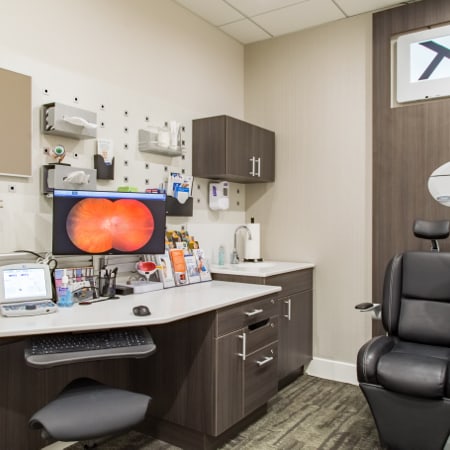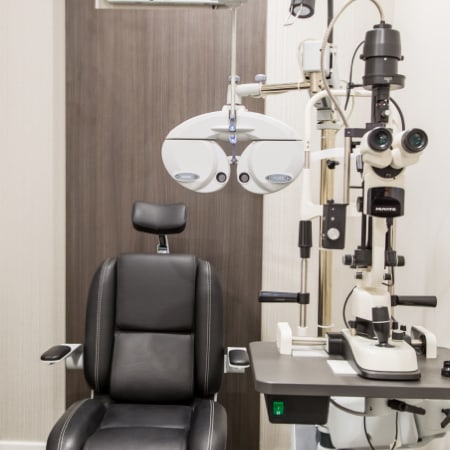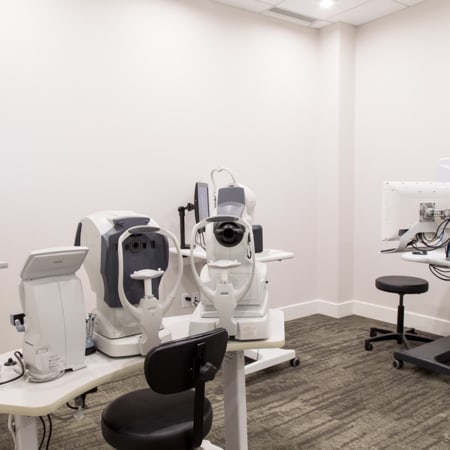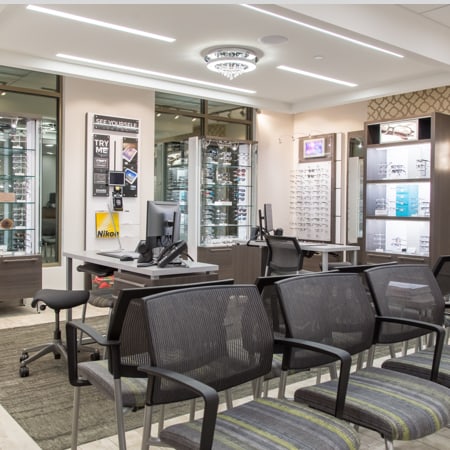Getting the Full Picture of Your Eye Health
One of the most important parts of a regular eye exam is checking the ocular health of the eye. Comprehensive eye exams can detect underlying conditions or diseases of the eye, even if there are no underlying symptoms.
Using our modern diagnostic technology, we aim to get the full picture of your vision health. If you’re due for your regular eye exam or are managing an eye condition or disease, visit us for an eye exam.

The Importance of Early Eye Disease Detection
When it comes to eye diseases and conditions, early detection is key. Letting underlying eye conditions progress can lead to serious vision problems and in serious cases, vision loss.
Making sure that you are attending bi-yearly or yearly comprehensive eye exams is the best way to stay on top of your ocular health and gives the best chance for diagnosing any vision issues early.


Our Diagnostic Eye Disease Technology
The diagnostic stage plays an important role in preserving your long-term vision. To stay ahead of any developing eye disease issues, it’s essential that our team be able to view your eyes and vision from multiple angles.
To thoroughly examine your ocular health, we use a variety of technological devices that view different parts of the eye and give us a thorough view of your vision.
In the diagnostic stage we can begin to prepare a treatment plan tailored to your specific needs.
Optical coherence tomography (OCT) is an imaging technology that takes cross-sectional and high-resolution images of the retina. This can identify retinal thickness and find abnormalities in the retina that could lead to retinal diseases.
Tonometry is a test that measures the pressure in the eye, or the intraocular pressure. This is an important test when diagnosing glaucoma, which is categorized by increased pressure in the eye. There are two main types of tonometry: non-contact and Goldmann applanation.
Non-contact tonometry is a test where a puff of air is sprayed into the eye and Goldmann applanation tonometry involves a probe being gently touched against the eye.
Corneal Topography is a diagnostic test in which the curvature of the cornea is measured based on the reflection of an image to determine the level of the curve. Topography measures not only the front surface of the cornea but the anterior and posterior as well for a 3D measurement.
This can be an important test for contact lens fittings or diagnosing keratoconus.
Exploring the Different Forms of Eye Disease
There are many eye diseases and conditions that we check in an eye exam using our diagnostic technology. The different forms of eye disease also exhibit different symptoms and sometimes no symptoms at all.
Consistent eye exams are important and allow our team to detect issues early and begin your eye disease management plan.
Some of these diseases and conditions are more common than others, but all are important to look out for to help avoid vision damage or loss.
Age-related macular degeneration (AMD) occurs when the macula of the eye becomes damaged due to age. This can cause a blurring of central vision and wavy vision in later stages.
There are two main types of AMD: wet and dry. Wet AMD is less common and occurs in the later stages of AMD. This type is categorized by abnormal blood vessels growing in the back of the eye, damaging the macula. Dry AMD is a more common form and is categorized by the macula thinning over time due to age.
Treatments for AMD are usually required for later-stage cases and include supplements, injections, or medications.
Cataracts are a condition where the lens of the eye becomes cloudy. This commonly happens with age and can cause symptoms such as vision blurriness, haziness, and dulling of colour.
Cataract surgery is a common procedure and an effective way to correct cataracts. In this surgery, the lens of the eye that has clouded is replaced, giving new life to your vision.
Glaucoma is a disease in which increased fluid in the eye causes increased pressure and can damage the optic nerve of the eye. This can cause vision blurriness, eye pain, headaches, halo vision, and in severe cases, vision loss.
Treatments for glaucoma can include medication or laser surgery.
You may see flashes of light or small spots in your vision—those are referred to as flashes and floaters. Flashes are bursts of light that occur in the corners of the eye. Floaters are specks, spots, or squiggles in your vision, which are small specks of debris that get stuck in the jelly-like protein of the eye.
On their own, flashes and floaters are not a disease but can be a sign of a condition or eye emergency. If these do not go away on their own, book an eye exam to get your eyes checked for conditions such as retinal detachment.
Diabetic eye disease, also known as diabetic retinopathy, is when the blood vessels at the back of the eye become damaged which can cause leaking of fluid, bleeding, or swelling. This can affect people with diabetes, and if not treated may cause vision loss.
Treatments for diabetic retinopathy may include injections, laser treatments, or surgery.
Conjunctivitis, more commonly known as pink eye, is an infection of the conjunctiva which is the thin inner membrane of the eye. This can cause redness, thick discharge, and watery eyes and is typically caused by bacteria or viruses, allergic reactions, or chemical exposure.
Uveitis is inflammation in the eye when it is fighting an infection or if your immune system is attacking the eye. This inflammation occurs in the uvea of the eye, which is the middle layer of the eye between the sclera and the retina. Uveitis can cause blurry vision, floaters, eye pain, redness, and light sensitivity.
Treatments for uveitis include eye drops, medication, injections, or implants.
Dry eye disease occurs when the eye is not producing enough healthy tears to properly lubricate the eye’s surface. You may have dry eye if your eyes are red, burning, gritty, or feel like there’s a foreign object in them.
There are many in-office or at-home treatments for dry eye, including heat and light therapies and eye drops.
Epiretinal membrane is a condition that affects the central part of the retina which is responsible for fine details, and tends to affect people over the age of 50. Symptoms are normally mild, but in severe cases can cause decreased vision or central vision loss, blurred vision, double vision, wavy vision, or trouble reading fine print.
The treatment option for the epiretinal membrane is a surgical procedure called vitrectomy in which fluid is removed from the eye.
Keratoconus causes an irregular shape in the cornea, causing it to bow. This can cause vision problems and needs corrective measures like glasses or contact lenses to help restore clear vision.
In more serious cases, surgery may be required to correct keratoconus.
Manage Your Eye Condition Before It Progresses
If you’re feeling the symptoms of an eye condition or disease, don’t wait to get your eye examined. The sooner we detect a vision condition, the sooner we can begin treatment.














